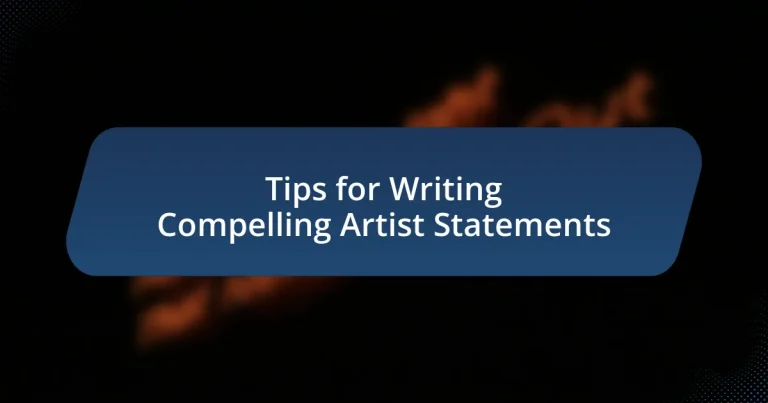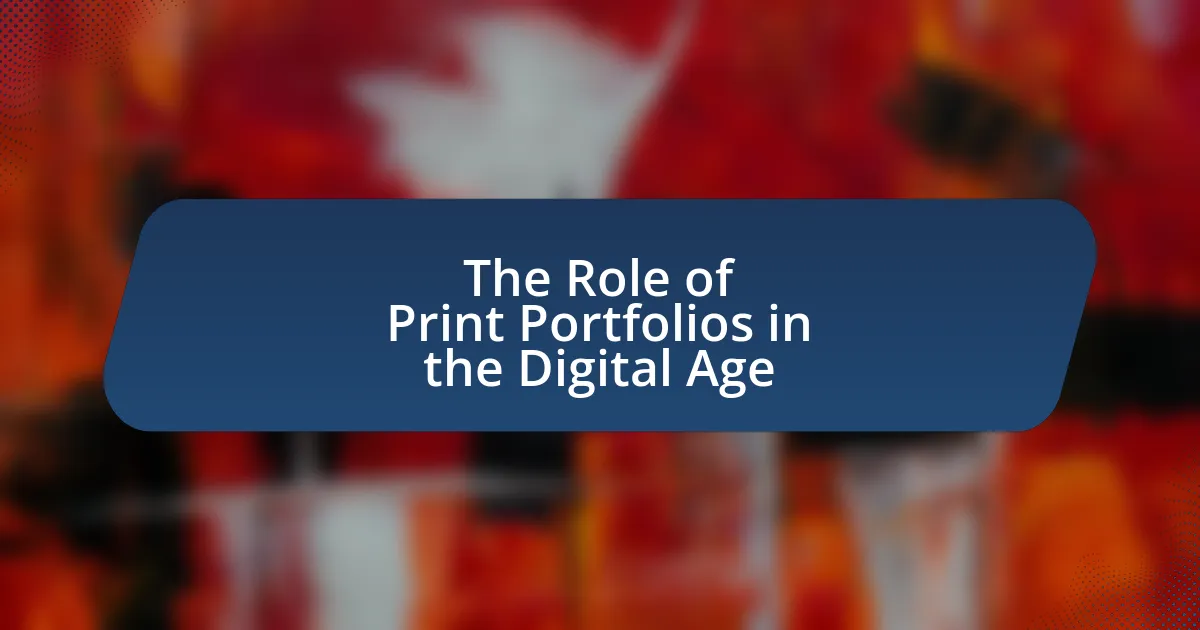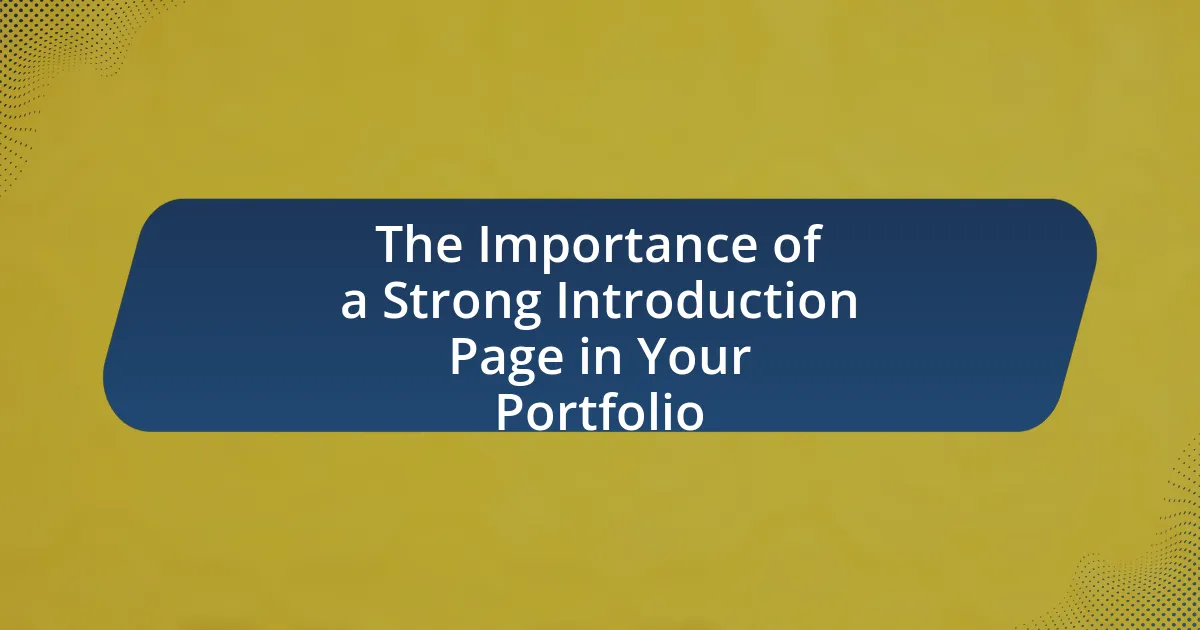An artist statement is a written description that articulates an artist’s intentions, concepts, and motivations behind their work, serving as a vital communication tool for engaging with viewers, galleries, and potential buyers. This article outlines the importance of artist statements, their role in exhibitions, and how they can enhance an artist’s portfolio. Key elements of a compelling statement include clarity, personal voice, and emotional engagement, while practical tips for writing effective statements emphasize the need for authenticity and clear communication. Additionally, the article discusses common pitfalls to avoid, techniques for articulating artistic vision, and the significance of tailoring statements for different audiences.
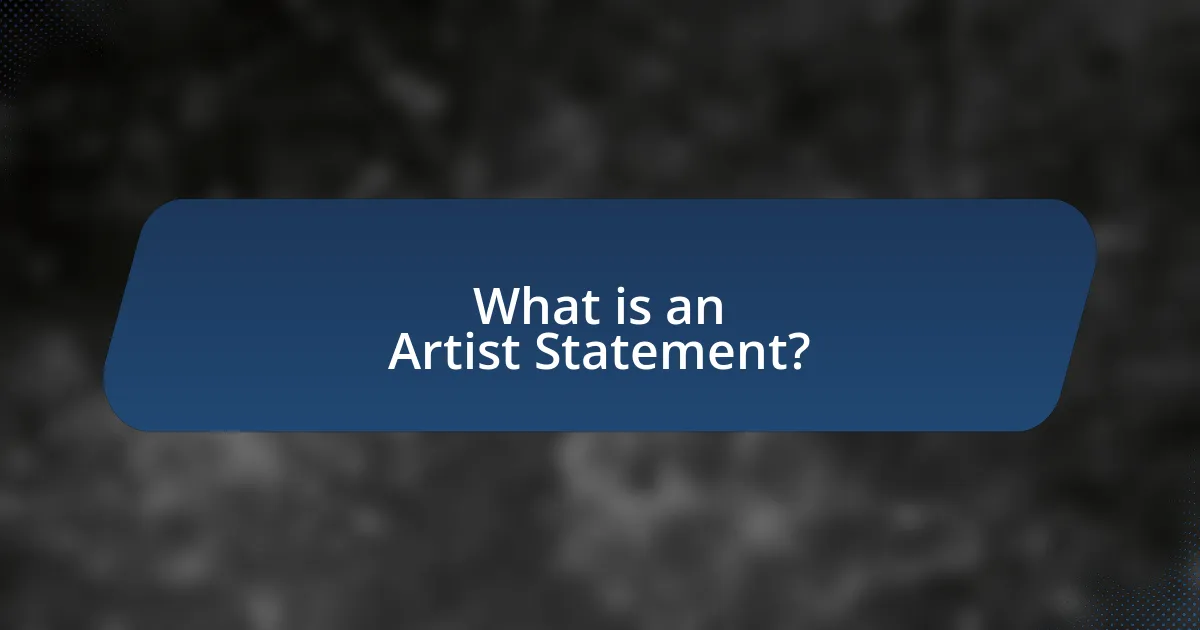
What is an Artist Statement?
An artist statement is a written description that conveys an artist’s intentions, concepts, and motivations behind their work. It serves as a tool for artists to communicate their creative process, themes, and the significance of their art to viewers, galleries, and potential buyers. Artist statements often include insights into the artist’s background, influences, and the context in which their work exists, helping to establish a deeper understanding of the artwork.
Why is an Artist Statement important for artists?
An Artist Statement is important for artists because it articulates their vision, intent, and the context of their work, helping to communicate their artistic identity to audiences. This statement serves as a critical tool for establishing a connection with viewers, galleries, and potential buyers, as it provides insight into the artist’s creative process and thematic concerns. Research indicates that a well-crafted Artist Statement can enhance an artist’s credibility and marketability, making it easier for them to engage with the art community and gain recognition.
What role does an Artist Statement play in exhibitions?
An Artist Statement serves as a critical tool in exhibitions by providing insight into the artist’s intentions, concepts, and the context of their work. This statement helps viewers understand the underlying themes and motivations behind the artwork, enhancing their engagement and appreciation. Research indicates that a well-crafted Artist Statement can significantly influence the audience’s interpretation and emotional response, as it frames the narrative surrounding the artwork. For instance, a study published in the Journal of Visual Art Practice highlights that artists who effectively communicate their vision through statements can foster a deeper connection with their audience, ultimately enriching the exhibition experience.
How can an Artist Statement enhance an artist’s portfolio?
An Artist Statement enhances an artist’s portfolio by providing context and insight into the artist’s work, intentions, and creative process. This contextualization helps viewers and potential buyers understand the underlying themes and concepts, making the artwork more relatable and impactful. Research indicates that a well-crafted Artist Statement can significantly influence the perception of art; for instance, a study published in the Journal of Arts Management, Law, and Society found that 70% of art buyers felt more connected to artworks accompanied by detailed explanations of the artist’s vision. Thus, an effective Artist Statement not only enriches the portfolio but also fosters a deeper engagement with the audience.
What are the key elements of a compelling Artist Statement?
A compelling Artist Statement includes clarity, personal voice, context, and emotional engagement. Clarity ensures that the artist’s intentions and concepts are easily understood, while personal voice reflects the unique perspective and style of the artist. Context situates the work within broader artistic movements or personal experiences, providing depth. Emotional engagement connects with the audience, inviting them to resonate with the artist’s journey and themes. These elements collectively enhance the statement’s effectiveness in communicating the artist’s vision and fostering a connection with viewers.
What personal insights should be included in an Artist Statement?
An Artist Statement should include personal insights such as the artist’s motivations, influences, and the themes explored in their work. These insights provide context for the audience, allowing them to understand the emotional and intellectual underpinnings of the artwork. For instance, an artist might discuss how personal experiences or cultural background shape their creative process, which can enhance the viewer’s connection to the art. Additionally, articulating the artist’s goals and aspirations can clarify their artistic vision, making the statement more impactful.
How does an artist’s background influence their statement?
An artist’s background significantly influences their statement by shaping their perspectives, themes, and techniques. For instance, an artist raised in a culturally rich environment may incorporate elements from their heritage, reflecting personal experiences and societal issues in their work. This connection is evident in artists like Frida Kahlo, whose Mexican heritage profoundly impacted her art and narrative style, emphasizing identity and pain. Additionally, an artist’s education and training can dictate their approach to materials and concepts, as seen in the works of those who studied at prestigious institutions, where exposure to various art movements informs their creative expression. Thus, an artist’s background serves as a foundational element that informs and enriches their artistic statement.
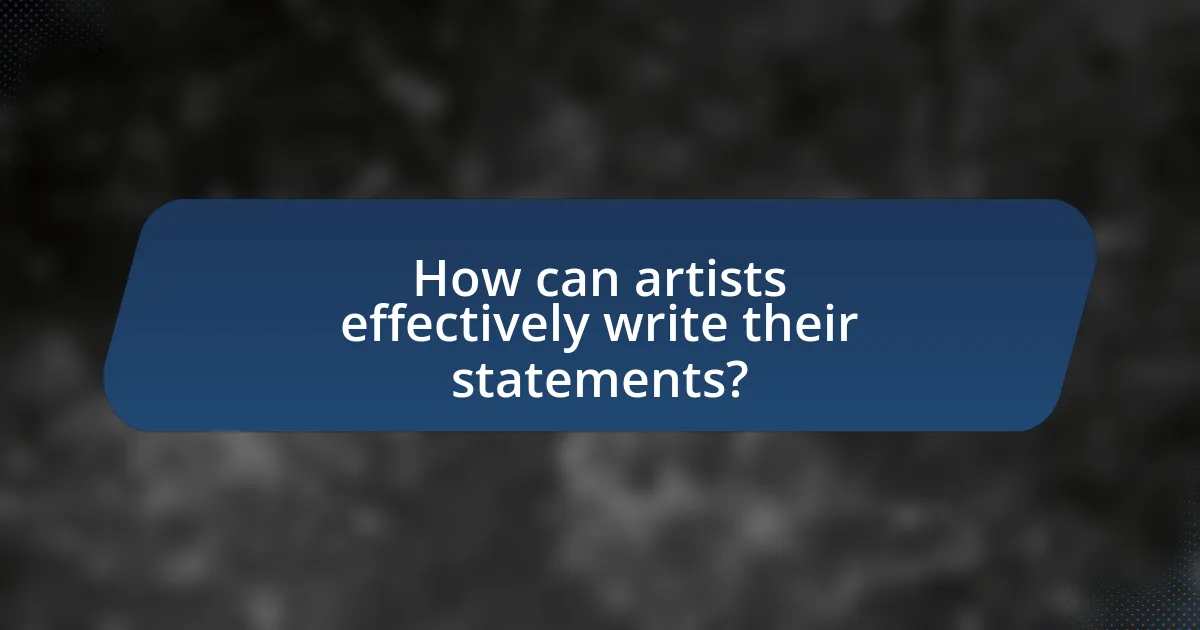
How can artists effectively write their statements?
Artists can effectively write their statements by clearly articulating their artistic vision, process, and the themes that inspire their work. This involves reflecting on personal experiences and motivations, which helps to create a genuine connection with the audience. Additionally, using concise language and avoiding jargon makes the statement accessible and engaging. Research indicates that artist statements that include specific examples of works and the context behind them resonate more with viewers, enhancing understanding and appreciation. For instance, a study published in the Journal of Visual Art Practice found that statements that provide insight into the artist’s intent and background significantly improve viewer engagement.
What steps should artists follow when drafting their statements?
Artists should follow these steps when drafting their statements: first, clearly define their artistic vision and intent, which serves as the foundation for the statement. Next, they should describe their creative process, detailing the techniques and materials used, as this provides insight into their work. Following this, artists should articulate the themes and concepts explored in their art, allowing viewers to connect on a deeper level. Additionally, including personal experiences or influences can enrich the narrative and make it more relatable. Finally, artists should revise and seek feedback to ensure clarity and impact, as a well-crafted statement enhances the understanding of their work.
How can artists identify their unique voice in writing?
Artists can identify their unique voice in writing by engaging in self-reflection and experimentation with different styles and themes. Self-reflection allows artists to explore their personal experiences, beliefs, and emotions, which can inform their writing and help them articulate their distinct perspective. Experimentation with various writing techniques, genres, and formats enables artists to discover what resonates with them and their audience. Research indicates that consistent practice and feedback from peers can further refine an artist’s voice, as it encourages growth and adaptation in their writing style.
What techniques can help in articulating artistic vision?
Techniques that can help in articulating artistic vision include the use of clear language, visual imagery, and personal narrative. Clear language ensures that the artist’s ideas are communicated effectively, avoiding jargon that may confuse the audience. Visual imagery allows the artist to paint a picture with words, helping the audience to visualize the concepts being expressed. Personal narrative connects the artist’s experiences and motivations to their work, making the vision relatable and engaging. These techniques are supported by research indicating that effective communication enhances audience understanding and appreciation of artistic intent.
What common mistakes should artists avoid in their statements?
Artists should avoid vague language and overly complex jargon in their statements. Clear and concise communication is essential for effectively conveying their artistic vision and intent. Additionally, artists should refrain from being overly self-promotional or defensive, as this can alienate the audience. Instead, focusing on the work itself and its context fosters a more genuine connection. Lastly, neglecting to proofread for grammatical errors and typos can undermine professionalism, detracting from the overall impact of the statement.
How can vague language undermine an Artist Statement?
Vague language can undermine an Artist Statement by obscuring the artist’s intent and diminishing the impact of their work. When statements lack specificity, they fail to convey the unique vision and emotional depth that define the artist’s practice, leading to misunderstandings or disinterest from the audience. For instance, using general terms like “inspired by life” instead of detailing specific experiences or influences can leave readers confused about the artist’s message. This lack of clarity can result in a disconnect between the artwork and its interpretation, ultimately weakening the artist’s ability to engage effectively with viewers and critics.
Why is it important to avoid jargon in an Artist Statement?
Avoiding jargon in an Artist Statement is crucial because it ensures clarity and accessibility for a broader audience. When artists use clear language, they effectively communicate their ideas and intentions, allowing viewers to connect with their work on a deeper level. Research indicates that statements free from jargon are more engaging and relatable, enhancing the likelihood that the audience will appreciate and understand the artist’s vision. This approach fosters inclusivity, as it invites individuals from various backgrounds to engage with the art without being alienated by complex terminology.

How can artists tailor their statements for different audiences?
Artists can tailor their statements for different audiences by adjusting the language, tone, and content to resonate with specific groups. For instance, when addressing art critics, artists should use technical terminology and focus on conceptual frameworks, while statements aimed at the general public should be more accessible and emotionally engaging. Research indicates that understanding audience demographics and preferences enhances communication effectiveness, as seen in studies on audience engagement in the arts. By analyzing feedback and adapting their narratives, artists can create statements that effectively connect with diverse audiences.
What considerations should be made for gallery submissions?
Gallery submissions require careful attention to presentation, content, and adherence to guidelines. Artists should ensure that their work is professionally presented, including high-quality images and accurate descriptions. Additionally, it is crucial to follow the specific submission guidelines provided by the gallery, which may include formatting requirements, deadlines, and the number of pieces to submit. Research indicates that galleries often prioritize submissions that clearly articulate the artist’s vision and intent, making a compelling artist statement essential. A well-crafted statement can enhance the submission by providing context and insight into the artwork, thereby increasing the chances of acceptance.
How can an Artist Statement be adapted for online platforms?
An Artist Statement can be adapted for online platforms by ensuring it is concise, visually engaging, and optimized for search engines. Online audiences typically prefer shorter, more direct content, so artists should aim for a statement that captures their essence in 150-300 words. Additionally, incorporating multimedia elements such as images or videos can enhance engagement and provide context to the written statement. Search engine optimization (SEO) techniques, such as using relevant keywords related to the artist’s work and style, can improve visibility on search engines. According to a study by HubSpot, content that includes images receives 94% more views than text-only content, reinforcing the importance of visual elements in online adaptations.
What should artists keep in mind when addressing potential buyers?
Artists should keep in mind the importance of clear communication and authenticity when addressing potential buyers. Clear communication involves articulating the inspiration, techniques, and concepts behind their work, which helps buyers connect emotionally and intellectually with the art. Authenticity is crucial, as buyers are often drawn to genuine narratives that reflect the artist’s unique perspective and experiences. Research indicates that buyers are more likely to purchase art when they feel a personal connection to the artist’s story, highlighting the significance of sharing one’s journey and intentions behind the artwork.
What are some best practices for revising an Artist Statement?
To effectively revise an Artist Statement, focus on clarity, authenticity, and conciseness. Begin by ensuring that the statement clearly articulates your artistic vision and intentions, avoiding jargon that may confuse the reader. Authenticity is crucial; reflect your true voice and experiences, as this resonates more with audiences. Additionally, aim for conciseness by eliminating unnecessary words and phrases, ensuring that every sentence contributes meaningfully to your narrative. Regularly seek feedback from peers or mentors, as external perspectives can highlight areas for improvement. Finally, review and edit multiple times, as revisions often reveal new insights and enhance the overall quality of the statement.
How can feedback from peers improve an Artist Statement?
Feedback from peers can significantly enhance an Artist Statement by providing diverse perspectives that highlight strengths and weaknesses. Peers can identify unclear language, suggest more impactful phrasing, and offer insights into how the statement resonates with different audiences. Research indicates that collaborative feedback processes lead to improved clarity and engagement in written communication, as seen in studies on peer review in educational settings. This collaborative approach ensures that the Artist Statement effectively communicates the artist’s vision and intent, making it more compelling and relatable to viewers.
What tools can assist in refining the writing process?
Writing software such as Grammarly, Hemingway Editor, and ProWritingAid can assist in refining the writing process. These tools provide real-time grammar and style suggestions, enhancing clarity and readability. For instance, Grammarly checks for over 400 types of grammatical errors and offers vocabulary enhancement suggestions, which can significantly improve the quality of writing. Hemingway Editor focuses on sentence structure and readability, highlighting complex sentences and passive voice, thus promoting concise writing. ProWritingAid combines grammar checking with style suggestions and in-depth reports on writing habits, making it a comprehensive tool for writers aiming to refine their craft.
What practical tips can help artists create compelling statements?
Artists can create compelling statements by focusing on clarity, authenticity, and emotional connection. Clarity involves using straightforward language to convey ideas without jargon, ensuring that the audience easily understands the artist’s intent. Authenticity requires artists to express their true selves and motivations, which resonates more deeply with viewers. Emotional connection can be achieved by sharing personal stories or experiences that inspired the artwork, making the statement relatable and engaging. Research indicates that statements that evoke emotion can significantly enhance viewer engagement, as demonstrated in studies on art appreciation and audience response.
